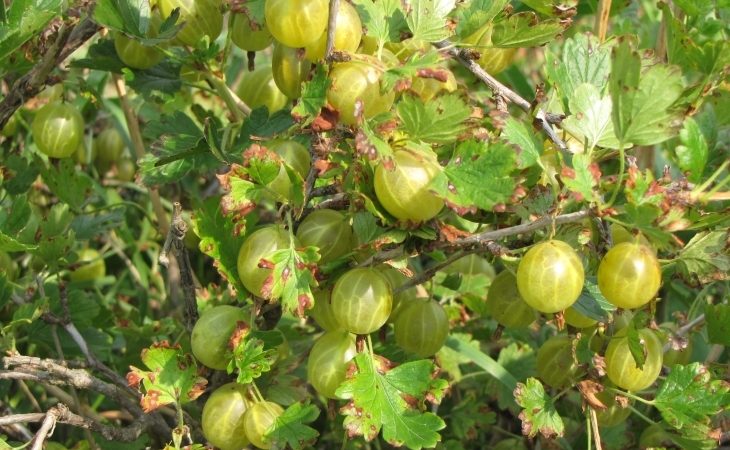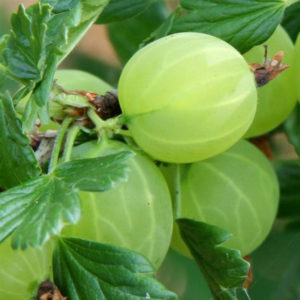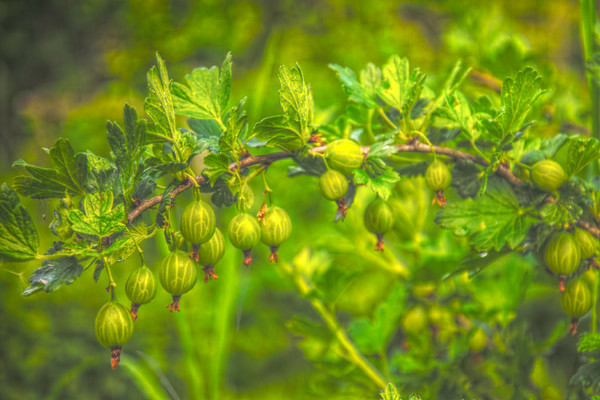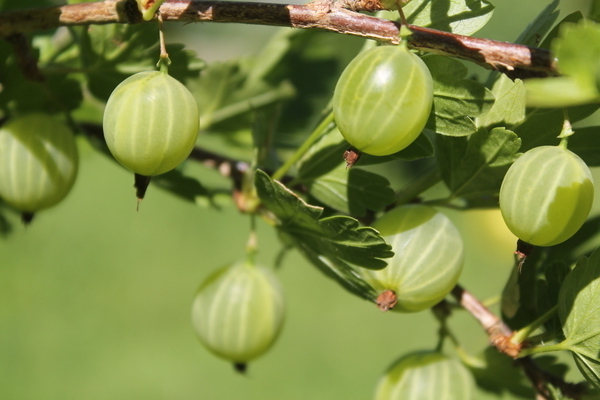Medium-late winter hardy "Finnish" gooseberry with sweet and sour berries
Gooseberry is a deservedly popular berry crop. It contains vitamins C, A, B and trace elements - iron, magnesium, potassium, phosphorus. The taste and appearance depend on the gooseberry variety. Finnish has fallen in love with gardeners not only for its good taste. You will find a description of the variety and cultivation features in the article.
The content of the article
What is this gooseberry variety
The Finnish gooseberry is characterized by a rich harvest and unpretentiousness. It tolerates uncomfortable environmental conditions, illness and attacks pests.
History of origin and distribution
Despite the fact that the shrub was mentioned in ancient times, a big breakthrough in breeding occurred only at the end of the 19th century. in Finland. In order for the gooseberry to develop actively, the breeders provided him with optimal conditions. For a long time it was grown in laboratory conditions. In Europe, this gooseberry has taken a leading position in comparison with others.
It was at that time that other varieties were brought from America to the countries of the Old World, and along with them powdery mildew spores. Breeders have tried to breed gooseberries that are resistant to this particular disease.
In 1999, the Finnish was entered in the State Register of Breeding Achievements. Since then, it has been allowed to grow and use in the North and North-West regions.
Subspecies
There are 3 types of Finnish gooseberries: red, green and yellow. The main characteristics are similar: a small bush with medium-sized leaves, covered with thorns, self-fertile, medium-late ripening, with a good yield.
Red
The bush grows up to 1.2 m. The berries are medium-sized, spherical, weighing 5-10 g. The taste is sweet with sourness. The aroma is pronounced. The fruits are covered with a thin, smooth reddish-purple skin. Ripening period - the end of July. From 7 to 12 kg of harvest are harvested from the bush.
Green
The height of the bush reaches 0.9-1.3 m. The size of the berries is average, the weight is 6-8 g. The olive-colored berries have an oval, elongated shape. Ripen in early July. The skin is thin, smooth. The gooseberry pulp is fragrant with a sweet and sour taste. Harvest from one bush - 9 kg.
Yellow

The shrub grows up to 1 m. Fruits weighing 5 g have an oval or oval-round shape. The skin is smooth, thin, yellow with a slight bloom. The berries taste like apricot. Ripens in early - mid-July. The yield is high - from 7 to 13 kg per bush.
Characteristics and description of the bushes
Gooseberry bushes are medium-sized, reaching a maximum height of 1.3 m, compact, not spreading. Adult stems are dark gray in color with a brown tint. Thick thorns are located along the entire length of the branches at an angle of 90 °.
Each bush has a dense foliage. The plant blooms in May. The flowers are medium-sized, yellow-green. Fruits are round in shape, with a smooth surface. The color of the berries depends on which subspecies the bush belongs to.

Resistant to temperatures
Finnish gooseberries were bred to be resistant to adverse conditions. It is a winter-hardy variety that grows successfully even in regions with short summers and long, severe winters. It can withstand frosts down to -38 ° C.Moreover, it does not need to be additionally covered before the onset of frost. Even if the shoots are damaged, they recover in one season. Since flowering occurs late, the flowers are not susceptible to frost. They do not fall off prematurely, and the yield does not decrease because of this.
Moisture and drought resistance
When choosing a place for gooseberries, make sure that the groundwater is not too close to the surface. The optimum depth is 5-6 m. The soil should not be too moist, otherwise the roots of the bush will rot.
But at the same time, gooseberries do not tolerate a lack of moisture. In dry summers, the bushes are watered so that the yield does not decrease, otherwise the berries will grow small and lethargic.
Disease and pest resistance
Finnish gooseberries rarely get sick. It is highly resistant to pests and diseases, especially powdery mildew and spheroteca. However, this variety is susceptible to anthracnose and septoria.
Characteristics and description of fruits

Gooseberry fruits ripen in early - late July, depending on the subspecies. Medium-sized berries weigh from 5 to 10 g. They have a sweet and sour taste and a bright aroma.
Due to the dense peel, the harvested crop is easy to transport. The fruits do not wrinkle during transportation and do not deteriorate within 5 days after collection.
Application area
Finnish gooseberries are grown on their own plot by both amateur gardeners and large farmers for sale. In addition to its pleasant taste, gooseberry has many beneficial properties:
- rich in vitamins C, E, B, A;
- contains pectin, carotene, iron, phosphorus, magnesium;
- removes excess fluid with edema;
- acts as an anti-inflammatory agent;
- has a tonic effect;
- raises hemoglobin;
- normalizes blood pressure;
- restores strength after illness.
The berries are consumed fresh, frozen for the winter without losing their beneficial properties. Jam, compotes, confitures, jam are prepared from them, used as a filling for pancakes, pies.
Gooseberries are not only used in sweet dishes. Sweet and sour sauce is made from it. Pickled, add as a side dish to meat and fish.
Instead of grapes, gooseberries are used as a base for wine or liqueur.
In cosmetology, gooseberry pulp and juice are valued. To combat age spots, rub the face with freshly squeezed juice several times a day. To moisturize dry skin, a mask of mashed berries is applied to the face.
Advantages and disadvantages of the variety
Finnish fell in love with gardeners for many positive qualities:
- high yield even after several years;
- self-fertility;

- increased frost resistance;
- unpretentious care;
- non-sprinkling of berries from a bush;
- resistance to diseases and pests;
- good transportability;
- pleasant taste and aroma;
- versatility in use.
Despite the impressive list of advantages, disadvantages are also taken into account before planting crops:
- the whole bush is covered with sharp thorns that scratch the skin when leaving and during harvest;
- ripe berries are not very large;
- the plant does not tolerate a lack and excess of moisture.
Growing technology
To grow a gooseberry that will yield a bountiful harvest every year, it is important to follow the rules of planting and caring for the plant.
Optimal conditions
The shrub likes well-lit, open areas, sheltered from the wind. Planting bushes along the fence is considered a good placement option. Gooseberries take root well in fertile, loose, well-fertilized soil. The optimum pH is 5.5-6.5.
Important! The bushes are planted at a distance of at least 2 m so that they do not block the light from each other.
Terms and rules of landing
Gooseberries are planted both in spring and autumn.... In the spring, the soil is expected to warm up to a temperature of + 8 ° C. This takes place in late April - early May. When planting in autumn, the seedling must have time to take root before the onset of frost. It is optimal to finish planting before mid-October.
The health of the future shrub and yield depend on the quality of the planting material. The seedling should have 2-3 strong stems with a root diameter of about 1 cm, without scratches, with leaves and fruit buds. It is important that the root system is well developed, without dry and damaged parts, the length of the roots reaches at least 20 cm.
Before planting, the seedlings are kept in a bucket with a growth stimulator for 4 to 12 hours.
Step-by-step algorithm for planting gooseberries:
- They dig a hole about 0.5 m deep and 0.45 m in diameter.
- Drainage is laid at the bottom.
- A small part of the soil mixture is poured, consisting of excavated soil, sand, peat and organic matter.
- The roots of the seedling are carefully straightened, set it vertically in the middle of the hole.
- The pit is covered with the remains of the soil mixture, compacted and watered at the rate of ½ water per bush.
So that the soil under the shrubbery retains moisture longer and fewer weeds form on it, the surface is sprinkled with mulch.
Further care
Finnish gooseberries are not a problem in leaving. The main thing is to water it on time, feed it with fertilizers and treat it from pests and diseases. Cropping and formation bush promotes better fruiting and prevents the development of diseases.

Watering
Bush in dry season watered at least 3 times - after flowering, during fruit formation and after harvest... To prevent the soil from drying out, it is periodically loosened.
You can't fill the plant either. Due to excess moisture, the fruits may crack, and the bush itself may die.
The bushes are watered by the drip method or from a ditch - a small ditch - at a distance of 40 cm from the trunk. It is not recommended to water by sprinkling, as moisture on the leaves and berries can provoke powdery mildew.
Weeding
Weed control is an important procedure for keeping gooseberries healthy. Weed grass takes nutrients from the soil, pests or infectious agents can settle on it. If the weeds are not removed, the bushes will get sick.
Top dressing
Usually feeding is divided into 3 stages:
- in the spring, nitrogen fertilizers are applied - 1 tbsp is dissolved in 10 liters of water. l. urea and water the bush;
- during flowering, potassium sulfate is used in the same proportion;
- during the period of active formation of gooseberry fruits, fertilize 1 tbsp. l. nitrophosphate and 2 tbsp. l. potassium humate per 10 liters of water.
Trimming and shaping
In early spring after the snow melts, dry, damaged branches of the bush are removed.
Autumn pruning is done to form a bush. Branches over 6 years old are removed at the root, leaving about 15 stems - 3 for each year of life.
It is allowed to cut off the green tops of the shoots in the summer. This is done to increase the size of the fruit.
Possible problems, diseases, pests
Finnish gooseberries are highly immune and rarely get sick. But in cool weather and with high humidity, fungal diseases can develop. This will be noticeable by the dense gray film covering the fruit. For the fight use fungicides "Title", "Topaz". If the plant is attacked by insect pests, for example, aphids or spider mites, use insecticides "Bitoxibacillin", "Fufanon".
For prophylaxis in the spring, the bushes are sprayed with Bordeaux liquid.
Wintering
Before wintering, weeds, fallen leaves, and dry branches are removed from under the bush. Since the variety is frost-resistant, it does not need special preparation for the cold.
Attention! So that in winter, with heavy snowfalls, the branches of the bush do not break, in the fall they are collected in a bunch and tied.
Reproduction

The Finnish variety reproduces well in vegetative ways:
- Layers. In the spring, elastic, healthy branches are chosen, bent to the ground, secured with staples and sprinkled with soil, which is kept moist. In the fall or next spring, the seedlings are dug up and transplanted.
- By cuttings. Cuttings 15 cm long are cut from young, green shoots in early summer. They plant them in a greenhouse and wait for them to take root.
- Also, gooseberries are propagated by seeds, but because of the complexity, this method is rarely used.
Features of cultivation depending on the region
Despite the fact that the variety is recommended for cultivation in the European part of the country, due to its winter hardiness and unpretentious care, it is popular in Siberia and the Urals.
There are no special differences in cultivation depending on the territory of the gooseberry. In warm climates, preference is given to autumn planting. In regions with short summers, gooseberries are planted in spring.
Additional measures to protect from the cold are taken in regions with severe winters. In the north, it is recommended to bend the stems to the ground and cover with non-woven fabric. Then the bushes will survive even severe frosts without loss.
Pollinating varieties
Gooseberry Finnish self-pollinated. It also bears fruit when planted alone. But if there are pollinating plants nearby, the yield of the Finnish will be higher. The best pollinator for him is the Lefort Seedling.
Reviews of summer residents

Gardeners who grow this variety note good yield, cold resistance, unpretentiousness and compactness of the bushes.
Galina Lebedeva, Krasnoyarsk: “All 3 Finnish gooseberry varieties grow on my site. In winter, the bushes do not freeze. In the third year, I harvested about 6 kg from each bush. The next year the harvest increased. Gooseberries do not require much maintenance. We eat fresh berries, cook compote and freeze some of them for the winter. "
Svetlana Yurieva, Chelyabinsk region: “My Finnish gooseberry has been growing for almost 5 years. Starting from the third year, there were already a lot of berries - about 5 kg per bush. I planted a yellow gooseberry because of the color and taste. I make wine out of it. The drink is aromatic and tasty. "
Mikhail Romanov, Kaluga region: “I planted a Finnish gooseberry because of its compactness, since there is not much space in the country house, and it does not grow much. The last winter the bushes overwintered without shelter. It's too early to talk about the yield ”.
Conclusion
Summer residents fell in love with Finnish gooseberries for their easy care, immunity to diseases and pests, the taste and aroma of berries. The fruits are well tolerated and stored for a long time. They are universal in use - they are eaten from the bush, canned and added to various dishes. Observing simple rules for planting and care, gardeners get a bountiful harvest of aromatic and tasty berries.